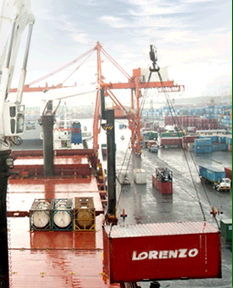
Philippine carrier Lorenzo Shipping Corporation’s (LSC) net loss widened to P231 million in the first half of the year from P18 million in the same period in 2015.
For the second quarter alone, loss expanded to P163.546 million from P44.489 million year-on-year.
Revenue for the first six months of 2016 dropped 1% to P1.107 billion from P1.114 billion in the same period in 2015.
Total direct costs for the period increased 9% to P1.1 billion from P1 billion in the same period a year ago, while cost of services grew to P1 billion, 9% higher than last year as cargo expenses went up to P577 million from P517 million.
Co-loading costs surged to P110 million in January-June of this year from P81 million in the comparative period of last year as the company resorted to co-loading to serve customers that were affected by vessel-related issues.
Craneage rate and storage fees also moved up in this period, while terminal expenses increased 5% to P112 million due to higher repair and maintenance costs of land-based equipment.
READ: Umali retires from Lorenzo Shipping
Despite the losses, LSC undertook marketing efforts to recapture lost accounts and acquire new ones. This helped bring in more cargoes, increasing volumes by 3% to 39,532 twenty-foot equivalent units (TEUs) in the first half of 2016 from 38,536 TEU in 2015.
The volume growth came despite overcapacity in the market, aggressive pricing by competitors, new entrants in the domestic liner market, and the drought that affected agricultural products in Mindanao, LSC said in a disclosure to the Philippine Stock Exchange.
LSC said it is now executing a major turnaround project to address declining profitability and service reliability as well as increasing costs. In 2015, the company reported a net loss of P231 million from a net income of P44 million in 2014, hampered by fewer vessel trips as four of its seven vessels underwent dry-docking.
The company said strategic programs being carried out to return to profitability include keeping vessels and shore-based equipment well-maintained and sea-based and land-based staff highly motivated.
Among its other programs are optimizing the use of vessels on profitable routes; underscoring timely delivery to markets at a competitive cost by underscoring innovation and agility; and implementing aggressive cost rationalization through improved operational processes and financial controls, including rigorous cost monitoring and accounting as well as automation of critical processes.
LSC manages a fleet of seven vessels with capacities ranging from 200 TEUs to 426 TEUs and deployed at key ports across the country. It also provides transport service for rolling cargoes such as heavy equipment, trucks, and vehicles, as well as non-containerized cargoes such as steel products and bridging materials. Delivering livestock cargoes in special vans is also part of its transport services.




